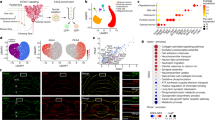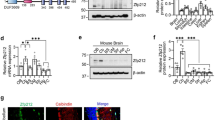Abstract
This protocol details a method for analyzing the expression of multiple genes from a single Purkinje neuron, including the determination of whether the gene expression is monoallelic or biallelic. The protocol describes how to extract a single, living Purkinje cell for reverse transcription, divide the cDNAs into three equal samples and subject those to triplicate amplification of multiple targets by two rounds of PCR (first a multiplex PCR then a gene-specific nested PCR) and finally discriminate the allelic expression of the transcript by direct sequencing of the PCR products. In optimal conditions, this method permits the analysis of the expression of 18 genes in a single Purkinje cell. This protocol can be completed in 5–6 d.
This is a preview of subscription content, access via your institution
Access options
Subscribe to this journal
Receive 12 print issues and online access
$259.00 per year
only $21.58 per issue
Buy this article
- Purchase on Springer Link
- Instant access to full article PDF
Prices may be subject to local taxes which are calculated during checkout





Similar content being viewed by others
References
Chess, A., Simon, I., Cedar, H. & Axel, R. Allelic inactivation regulates olfactory receptor gene expression. Cell 78, 823–834 (1994).
Shen, S.I., Gao, C. & Singer-Sam, J. Use of a reverse transcriptase-polymerase chain reaction assay to analyze allele-specific expression in individual hippocampal neurons. Mol. Genet. Metab. 63, 96–102 (1998).
Rhoades, K.L. et al. Allele-specific expression patterns of interleukin-2 and Pax-5 revealed by a sensitive single-cell RT-PCR analysis. Curr. Biol. 10, 789–792 (2000).
Esumi, S. et al. Monoallelic yet combinatorial expression of variable exons of the protocadherin-α gene cluster in single neurons. Nat. Genet. 37, 171–176 (2005).
Kaneko, R. et al. Allelic gene regulation of Pcdh-α and Pcdh-γ clusters involving both monoallelic and biallelic expression in single Purkinje cells. J. Biol. Chem. 281, 30551–30560 (2006).
Kohmura, N. et al. Diversity revealed by a novel family of cadherins expressed in neurons at a synaptic complex. Neuron 20, 1137–1151 (1998).
Wu, Q. & Maniatis, T. A striking organization of a large family of human neural cadherin-like cell adhesion genes. Cell 97, 779–790 (1999).
Yagi, T. & Takeichi, M. Cadherin superfamily genes: functions, genomic organization, and neurologic diversity. Genes Dev. 14, 1169–1180 (2000).
Hirayama, T. & Yagi, T. The role and expression of the protocadherin-alpha clusters in the CNS. Curr. Opin. Neurobiol. 16, 336–342 (2006).
Chess, A. Monoallelic expression of protocadherin genes. Nat. Genet. 37, 120–121 (2006).
Murata, Y., Hamada, S., Morishita, H., Mutoh, T. & Yagi, T. Interaction with protocadherin-γ regulates the cell surface expression of protocadherin-α. J. Biol. Chem. 279, 49508–49516 (2004).
Hu, J.F., Oruganti, H., Vu, T.H. & Hoffman, A.R. Tissue-specific imprinting of the mouse insulin-like growth factor II receptor gene correlates with differential allele-specific DNA methylation. Mol. Endocrinol. 12, 220–232 (1998).
Hashimoto, K. & Kano, M. Postnatal development and synapse elimination of climbing fiber to Purkinje cell projection in the cerebellum. Neurosci. Res. 53, 221–228 (2005).
Tamamaki, N. et al. Green fluorescent protein expression and colocalization with calretinin, parvalbumin, and somatostatin in the GAD67-GFP knock-in mouse. J. Comp. Neurol. 467, 60–79 (2003).
Osada, T. et al. Developmental pluripotency of the nuclei of neurons in the cerebral cortex of juvenile mice. J. Neurosci. 25, 8368–8374 (2005).
Wu, S.X. et al. Pyramidal neurons of upper cortical layers generated by NEX-positive progenitor cells in the subventricular zone. Proc. Natl. Acad. Sci. USA 102, 17172–17177 (2005).
Neves, G., Zucker, J., Daly, M. & Chess, A. Stochastic yet biased expression of multiple Dscam splice variants by individual cells. Nat. Genet. 36, 240–246 (2004).
Oberdick, J., Baader, S.L. & Schilling, K. From zebra stripes to postal zones: deciphering patterns of gene expression in the cerebellum. Trends Neurosci. 21, 383–390 (1998).
Taguchi, Y., Koide, T., Shiroishi, T. & Yagi, T. Molecular evolution of cadherin-related neuronal receptor/protocadherin (CNR/Pcdhα) gene cluster in Mus musculus subspecies. Mol. Biol. Evol. 22, 1433–1443 (2005).
Acknowledgements
We thank H. Kato, M. Kawaguchi and K. Hirano for their assistance and discussion. This work was supported by a Grant-in-Aid for Scientific Research on Priority Areas (Molecular Brain Science) from the Ministry of Education, Culture, Sports, Science and Technology of Japan (14104025 to T.Y.), Grants-in-Aid from the Ministry of Education, Science, Sports, and Culture of Japan (17024034 to T.Y.) and CREST in the Japan Science and Technology Corporation (T.Y.).
Author information
Authors and Affiliations
Corresponding author
Ethics declarations
Competing interests
The authors declare no competing financial interests.
Rights and permissions
About this article
Cite this article
Esumi, S., Kaneko, R., Kawamura, Y. et al. Split single-cell RT-PCR analysis of Purkinje cells. Nat Protoc 1, 2143–2151 (2006). https://doi.org/10.1038/nprot.2006.343
Published:
Issue Date:
DOI: https://doi.org/10.1038/nprot.2006.343
This article is cited by
-
Direct metabolomics for plant cells by live single-cell mass spectrometry
Nature Protocols (2015)
-
Expansion of stochastic expression repertoire by tandem duplication in mouse Protocadherin-α cluster
Scientific Reports (2014)
-
Stochastic profiling of transcriptional regulatory heterogeneities in tissues, tumors and cultured cells
Nature Protocols (2013)
-
A long noncoding RNA contributes to neuropathic pain by silencing Kcna2 in primary afferent neurons
Nature Neuroscience (2013)
-
Comprehensive qPCR profiling of gene expression in single neuronal cells
Nature Protocols (2012)
Comments
By submitting a comment you agree to abide by our Terms and Community Guidelines. If you find something abusive or that does not comply with our terms or guidelines please flag it as inappropriate.



